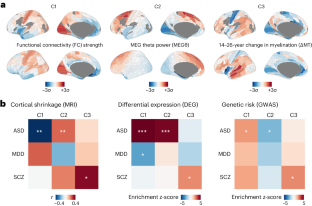Gene expression in the human cortex is shown to exhibit a generalizable three-component architecture that reflects neuronal, metabolic, and immune programmes of healthy brain development. The three components have distinct associations with autism spectrum disorder and schizophrenia, revealing connections between previously unrelated results from studies of case–control neuroimaging, differential gene expression, and genetic risk.
This is a preview of subscription content, access via your institution
Access options
Access Nature and 54 other Nature Portfolio journals
Get Nature+, our best-value online-access subscription
$29.99 / 30 days
cancel any time
Subscribe to this journal
Receive 12 print issues and online access
$209.00 per year
only $17.42 per issue
Buy this article
- Purchase on Springer Link
- Instant access to full article PDF
Prices may be subject to local taxes which are calculated during checkout

References
Hawrylycz, M. J. et al. An anatomically comprehensive atlas of the adult human brain transcriptome. Nature 489, 391–399 (2012). The original paper presenting the AHBA, in which principal components of cortical gene expression were suggested to reflect brain organization.
Burt, J. B. et al. Hierarchy of transcriptomic specialization across human cortex captured by structural neuroimaging topography. Nat. Neurosci. 21, 1251–1259 (2018). This paper characterizes the first component of cortical gene expression, C1, as reflecting a neuronal hierarchy defined by tract-tracing and indexed by structural neuroimaging.
Sydnor, V. J. et al. Neurodevelopment of the association cortices: patterns, mechanisms, and implications for psychopathology. Neuron 109, 2820–2846 (2021). This review proposes that neurodevelopment involves a ‘sensorimotor–association axis’ defined by ten brain maps, of which one is the cortical gene expression component C1.
Merikangas, A. K. et al. What genes are differentially expressed in individuals with schizophrenia? A systematic review. Mol. Psychiatry 27, 1373–1383 (2022). This review demonstrates the lack of consistency in genes linked to schizophrenia across differential expression studies, which are also inconsistent with GWAS.
Johnson, M. B. & Hyman, S. E. A critical perspective on the synaptic pruning hypothesis of schizophrenia pathogenesis. Biol. Psychiatry 92, 440–442 (2022). This commentary calls for an understanding of synaptic pruning in schizophrenia compared with healthy adolescent neurodevelopment.
Additional information
Publisher’s note Springer Nature remains neutral with regard to jurisdictional claims in published maps and institutional affiliations.
This is a summary of: Dear, R. et al. Cortical gene expression architecture links healthy neurodevelopment to the imaging, transcriptomics and genetics of autism and schizophrenia. Nat. Neurosci. https://doi.org/10.1038/s41593-024-01624-4 (2024).
Rights and permissions
About this article
Cite this article
Three patterns link brain organization to genes in health and disease. Nat Neurosci (2024). https://doi.org/10.1038/s41593-024-01625-3
Published:
DOI: https://doi.org/10.1038/s41593-024-01625-3
